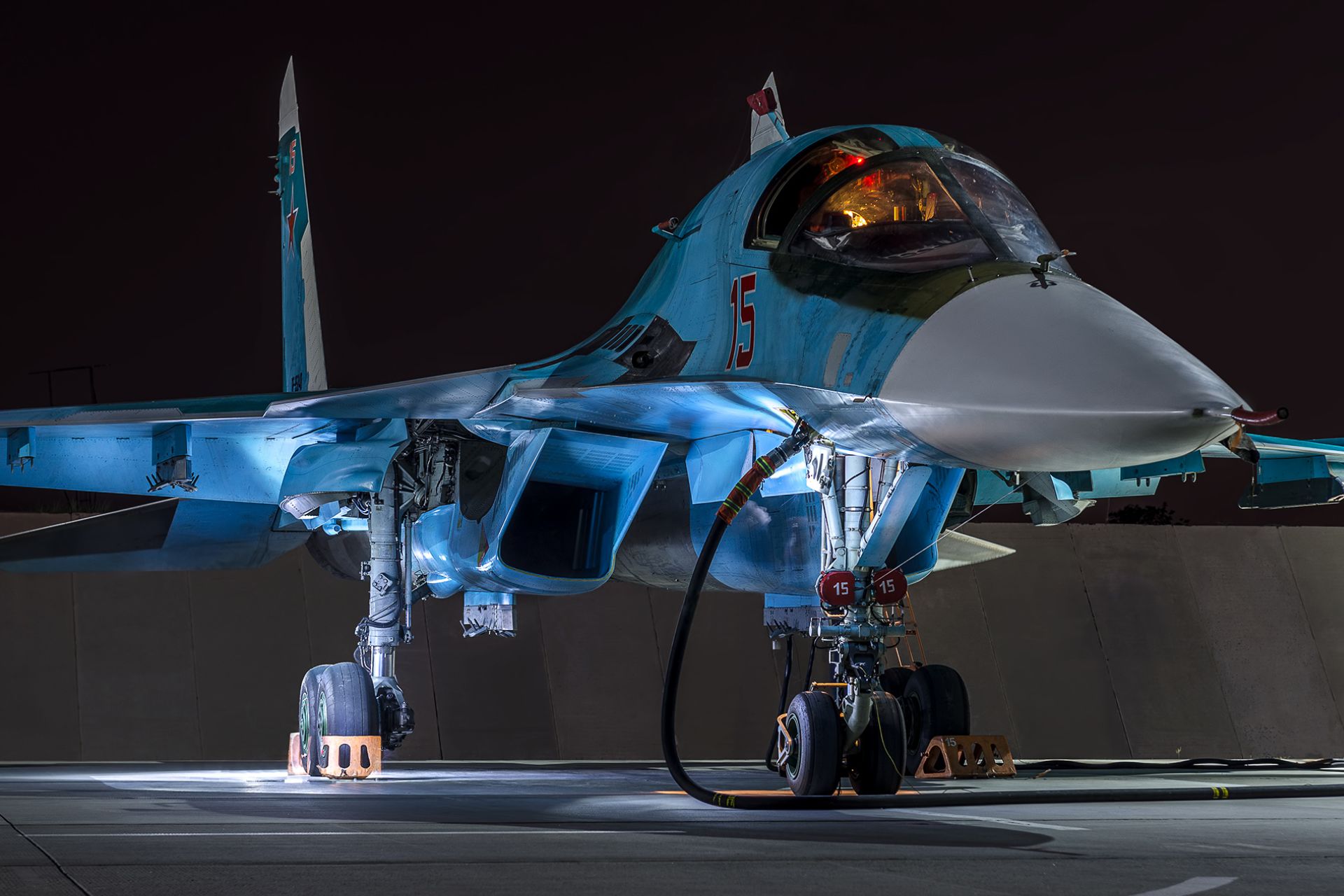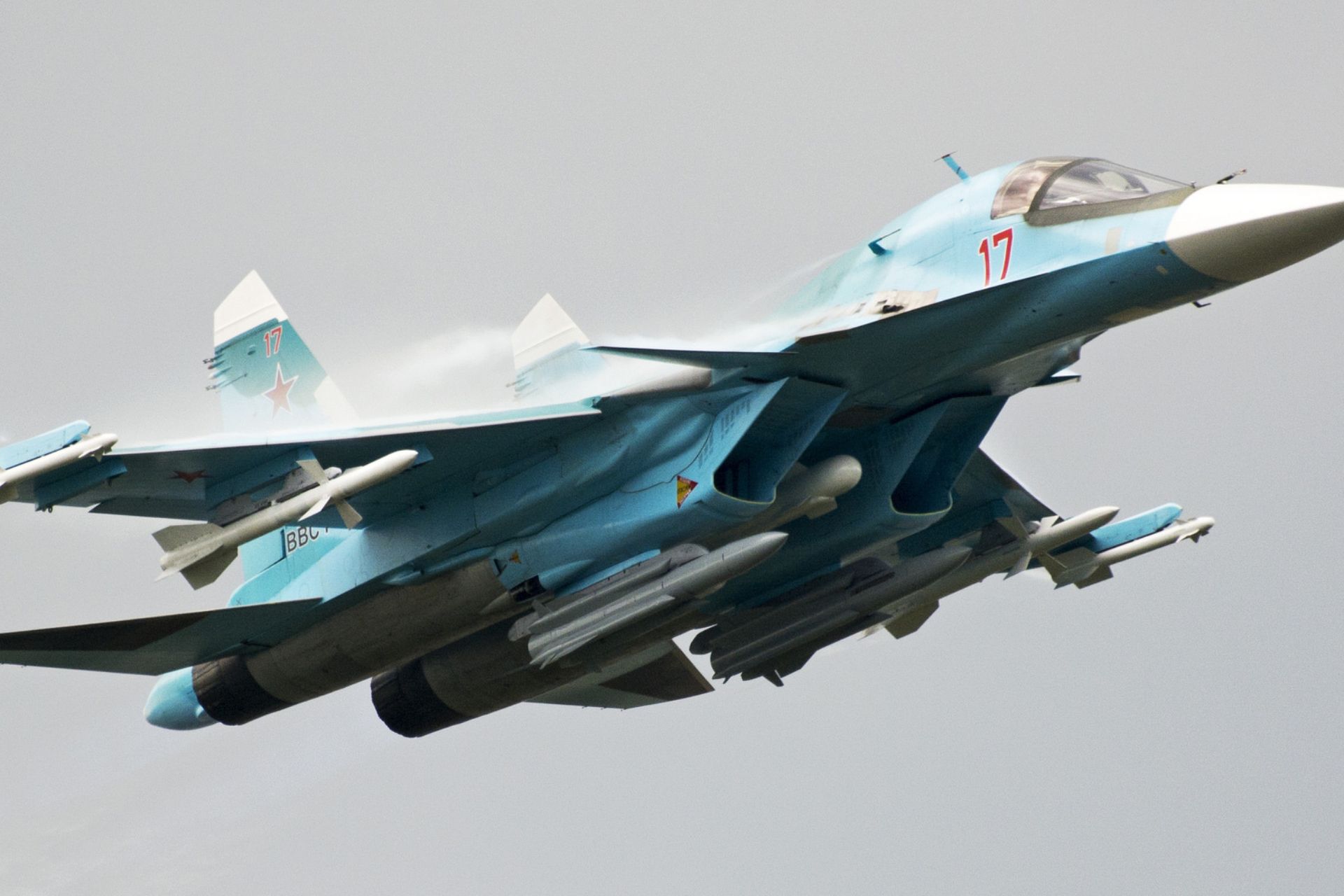Weapon Brief | Russian Su-34: alarming crossover between two aerial concepts that threatens F-16

{loadposition bannertop}
{loadposition sidebarpub}
The Russian Aerospace Forces have a vast fleet composed of various types of aircraft. One of the most interesting jets in this fleet is the Su-34 Fullback. The Su-34 Fullback is a versatile fighter-bomber used by the Russian Aerospace Forces. It combines both bombing and air combat capabilities on a single platform. As both a bomber and a fighter jet, the Su-34 is the preferred choice of Russian commanders for eliminating difficult ground targets. However, the aircraft has suffered heavy losses during the war in Ukraine, which has exposed its weaknesses, yet it remains a threat to Ukrainian fighters.Follow Army Recognition on Google News at this link
Su-34 on standby waiting for next deployment, in 2021 (Picture source: Alexander Beltyukov)
Doctrinal Point:
In the aerial domain, a distinction is made between aircraft dedicated to air combat and those dedicated to bombing. This doctrine in Europe is relatively outdated, as it was prevalent during the Cold War era. For instance, the differences between the French Mirage 2000 in its 2000-D or 2000-C versions illustrate this. After the Cold War, European aircraft became multirole, capable of performing both ground attacks and air combat, even achieving air superiority (a concept aimed at engaging multiple targets simultaneously).
The Americans did not entirely adopt this change in doctrine. They still have dedicated bombers like the B1 Lancer, B2 Spirit, B-52 Stratofortress, and the B-21 Raider in development. They also have dedicated fighters, such as the F-22 and F-15, which have some multirole capabilities but are more focused on air combat. The F-16 (designed for both domestic use and export) has a stronger multirole dynamic but remains primarily a fighter, as evidenced by the debate over the arrival of F-16s in Ukraine. The F-35 stands out slightly with an enhanced ground attack capability.
The Russians, facing similar budgetary constraints as the Europeans, have pursued a lighter multirole approach with the Su-35 and MiG-29, which are still designed in terms of equipment and maneuverability to gain an advantage over enemy aircraft. Another category of subsonic jets in the Russian Aerospace Forces includes aircraft dedicated to ground attack, such as the Su-25, designed to rival the A-10 Thunderbolt. The Su-25 has low speed but enormous carrying capacity. Finally, there are the so-called strategic bombers for very long-range missions, modeled after the American B2 and B1 bombers: the Tupolev Tu-160 (Blackjack) and Tupolev Tu-22M (Backfire).
Russian SU-34 demonstrating payload capacities during MAKS , russian air show ( Picture source: Russian spotters)
Su-34 Fullback: Two Aircraft in One
Nicknamed “Fullback” by NATO, the Su-34 is a twin-engine fighter-bomber with a two-person crew: a pilot and a weapons officer. The aircraft can operate in all weather conditions and conduct attack, bombing, and combat missions.
The Russian Aerospace Forces primarily use the Su-34 Fullback in a tactical bombing role. To meet this requirement, Sukhoi’s designers equipped the Fullback with an improved cockpit featuring additional armor to withstand ground-based anti-aircraft fire. Additionally, the fighter-bomber is equipped with advanced electronic warfare countermeasures to jam or destroy enemy surface-to-air missiles.
The Su-34 Fullback can reach a speed of Mach 2 (approximately 2,400 km/h) and has an operational range of 4,000 km without refueling. It is designed to withstand high pressure (up to 9 G) and has a pressurized cabin.
However, it is in terms of armament that the Su-34 Fullback truly stands out. The aircraft can carry up to 18,000 pounds of ordnance on 12 hardpoints, including radar-guided R-77 air-to-air missiles for beyond-visual-range engagements; heat-seeking R-73 air-to-air missiles; radar-guided R-27 air-to-air missiles; Kh-59, Kh-58, Kh-38, Kh-29, and Kh-25 air-to-ground missiles; and Kh-65 and Kh-36 cruise missiles. The fighter-bomber can also carry Kh-35 and Kh-31 anti-ship missiles and a wide selection of conventional bombs. Additionally, the Su-34 is equipped with a 30mm Gryazev-Shipunov GSh-30-1 cannon with 120 rounds for ground attack and air combat.
With these munitions, the Su-34 Fullback can strike targets up to 250 km away, and the Russian Aerospace Forces have extensively used it during operations in Ukraine. However, Su-34 squadrons have suffered heavy losses in the conflict, with at least 26 fighter-bombers lost so far. In total, the Russian Aerospace Forces operate around 150 of these aircraft, each costing approximately $85 million.
The idea of integrating multiple missions into a single aircraft is not new. The American stealth fighter F-35 Lightning II, for example, is capable of conducting six missions simultaneously with the appropriate munitions. The idea behind this type of aircraft is to streamline missions and promote a more efficient fleet of aircraft. The U.S. military envisioned that the F-35 Lightning II would take over the roles of several older aircraft that would eventually be retired from service.
Overall, the Su-34 is a capable aircraft, able to perform multiple missions. It is particularly useful when it has sufficient air and ground support to continue its tactical bombing missions without worrying about enemy fighters or anti-aircraft systems. In the absence of such support, its size and radar signature make it vulnerable.
SU-34 on take off procedure- on taxiway- place and date unknown ( Picture source: reddit/aviation)

{loadposition bannertop}
{loadposition sidebarpub}
The Russian Aerospace Forces have a vast fleet composed of various types of aircraft. One of the most interesting jets in this fleet is the Su-34 Fullback. The Su-34 Fullback is a versatile fighter-bomber used by the Russian Aerospace Forces. It combines both bombing and air combat capabilities on a single platform. As both a bomber and a fighter jet, the Su-34 is the preferred choice of Russian commanders for eliminating difficult ground targets. However, the aircraft has suffered heavy losses during the war in Ukraine, which has exposed its weaknesses, yet it remains a threat to Ukrainian fighters.
Follow Army Recognition on Google News at this link
Su-34 on standby waiting for next deployment, in 2021 (Picture source: Alexander Beltyukov)
Doctrinal Point:
In the aerial domain, a distinction is made between aircraft dedicated to air combat and those dedicated to bombing. This doctrine in Europe is relatively outdated, as it was prevalent during the Cold War era. For instance, the differences between the French Mirage 2000 in its 2000-D or 2000-C versions illustrate this. After the Cold War, European aircraft became multirole, capable of performing both ground attacks and air combat, even achieving air superiority (a concept aimed at engaging multiple targets simultaneously).
The Americans did not entirely adopt this change in doctrine. They still have dedicated bombers like the B1 Lancer, B2 Spirit, B-52 Stratofortress, and the B-21 Raider in development. They also have dedicated fighters, such as the F-22 and F-15, which have some multirole capabilities but are more focused on air combat. The F-16 (designed for both domestic use and export) has a stronger multirole dynamic but remains primarily a fighter, as evidenced by the debate over the arrival of F-16s in Ukraine. The F-35 stands out slightly with an enhanced ground attack capability.
The Russians, facing similar budgetary constraints as the Europeans, have pursued a lighter multirole approach with the Su-35 and MiG-29, which are still designed in terms of equipment and maneuverability to gain an advantage over enemy aircraft. Another category of subsonic jets in the Russian Aerospace Forces includes aircraft dedicated to ground attack, such as the Su-25, designed to rival the A-10 Thunderbolt. The Su-25 has low speed but enormous carrying capacity. Finally, there are the so-called strategic bombers for very long-range missions, modeled after the American B2 and B1 bombers: the Tupolev Tu-160 (Blackjack) and Tupolev Tu-22M (Backfire).

Russian SU-34 demonstrating payload capacities during MAKS , russian air show ( Picture source: Russian spotters)
Su-34 Fullback: Two Aircraft in One
Nicknamed “Fullback” by NATO, the Su-34 is a twin-engine fighter-bomber with a two-person crew: a pilot and a weapons officer. The aircraft can operate in all weather conditions and conduct attack, bombing, and combat missions.
The Russian Aerospace Forces primarily use the Su-34 Fullback in a tactical bombing role. To meet this requirement, Sukhoi’s designers equipped the Fullback with an improved cockpit featuring additional armor to withstand ground-based anti-aircraft fire. Additionally, the fighter-bomber is equipped with advanced electronic warfare countermeasures to jam or destroy enemy surface-to-air missiles.
The Su-34 Fullback can reach a speed of Mach 2 (approximately 2,400 km/h) and has an operational range of 4,000 km without refueling. It is designed to withstand high pressure (up to 9 G) and has a pressurized cabin.
However, it is in terms of armament that the Su-34 Fullback truly stands out. The aircraft can carry up to 18,000 pounds of ordnance on 12 hardpoints, including radar-guided R-77 air-to-air missiles for beyond-visual-range engagements; heat-seeking R-73 air-to-air missiles; radar-guided R-27 air-to-air missiles; Kh-59, Kh-58, Kh-38, Kh-29, and Kh-25 air-to-ground missiles; and Kh-65 and Kh-36 cruise missiles. The fighter-bomber can also carry Kh-35 and Kh-31 anti-ship missiles and a wide selection of conventional bombs. Additionally, the Su-34 is equipped with a 30mm Gryazev-Shipunov GSh-30-1 cannon with 120 rounds for ground attack and air combat.
With these munitions, the Su-34 Fullback can strike targets up to 250 km away, and the Russian Aerospace Forces have extensively used it during operations in Ukraine. However, Su-34 squadrons have suffered heavy losses in the conflict, with at least 26 fighter-bombers lost so far. In total, the Russian Aerospace Forces operate around 150 of these aircraft, each costing approximately $85 million.
The idea of integrating multiple missions into a single aircraft is not new. The American stealth fighter F-35 Lightning II, for example, is capable of conducting six missions simultaneously with the appropriate munitions. The idea behind this type of aircraft is to streamline missions and promote a more efficient fleet of aircraft. The U.S. military envisioned that the F-35 Lightning II would take over the roles of several older aircraft that would eventually be retired from service.
Overall, the Su-34 is a capable aircraft, able to perform multiple missions. It is particularly useful when it has sufficient air and ground support to continue its tactical bombing missions without worrying about enemy fighters or anti-aircraft systems. In the absence of such support, its size and radar signature make it vulnerable.

SU-34 on take off procedure- on taxiway- place and date unknown ( Picture source: reddit/aviation)





